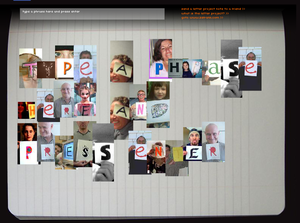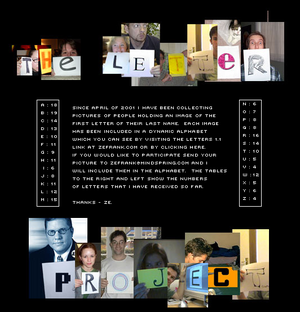Letters 1.2
Summary of the Piece
Letters 1.2 is an interactive, online toy created by Youtuber and online artist Ze Frank. In this piece, the viewer interacts with the art by typing a message into a small text box in the upper left corner of the webpage and then hitting the Enter key. The program then spells out the message through a series of photographs, which are placed on top of an image of a lined notebook.
Each photograph depicts an individual holding a piece of paper with a letter written on it or with the letter added digitally. Each letter also has a number of different photographs to represent it, so while the structure of the sentence remains the same, the photographs are in a constant state of flux. They rapidly change from picture to picture, pausing on one specific photo for a few second before starting again.
The user can then choose to write a new message, or they can send their current message to someone by clicking a link in the upper right corner of the webpage.
Creation of the Piece
A link in the upper right corner of the Letters 1.2 webpage asks "what is the letter project?" and clicking it takes the viewer to a different, static page where the artist explains the creation of the piece:
- "Since April of 2001 I have been collecting picture of people holding an image of the first letter of their last name.
- Each image has been included in a dynamic alphabet..." - Ze Frank [1]
This collection of letters is separately known as the Letter Project and can be defined as an Affinity space, which is a online place created through the participation of people who have a common interest or goal. This is different from the idea of an online "community", which suggests the idea of membership. The term "spaces" refers more to a digital place where the most important component of a member is not their race, gender, age, etc, but their "common endeavour" or their potential to learn and share about a particular theme or project.[2]. These spaces allow a project to function without the concern of who counts a member since the only requirement is interest. Affinity Spaces therefore act as a much more free flowing virtual space that encourages participation and the sharing of knowledge.
In the Letter Project, Ze Frank encourages the sharing of knowledge in the form of photographs and letters by displaying two tables on either side of this description. The tables contain all 26 letters of the alphabet with the number of photographs pertaining to that letter next to them. For example, there are 19 photographs available for the letter B, meaning 19 people whose last name started with a B sent in a photograph, while there are only 4 photographs available for the letters V or Z.
The description also includes an email address where the viewer can send in their own picture to Ze Frank, and therefore both projects are still ongoing.
Content and Meaning of the Work
In a TED Talk titled "My Web Playroom", Ze Frank highlighted and demonstrated several projects he had created by asking his online audience to participate, whether by taking photos, recording sounds or creating pieces themselves. Examples of such works include collections of images like "Young Me, Now Me", or songs he had created by asking people to record themselves singing along to a sample of music, and then combining these vocal tracks together to create a chorus of different voices, such as in the chillout song. All of these projects can be defined as online Affinity Spaces.
Ze Frank's work often revolves around the idea of sharing and the understanding of different emotions, such as fear, pain and humour or the exploration of new creative ideas and project made possible through the internet. In his Ted Talk, he describes the idea of a new, digital space in which people are now living:
- "On street corners everywhere, people are looking at their cell phones, and it's easy to dismiss this as some sort of bad trend in human culture. But the truth is life is being lived there. When they smile -- right, you've seen people stop -- all of a sudden, life is being lived there, somewhere up in that weird, dense network. And this is it, right, to feel and be felt. It's the fundamental force that we're all after. We can build all sorts of environments to make it a little bit easier, but ultimately, what we're trying to do is really connect with one other person. And that's not always going to happen in physical spaces. It's also going to now happen in virtual spaces, and we have to get better at figuring that out."[3]
Letters 1.2 is a work that explores this idea of connecting in these virtual spaces. Ze Frank's pieces allow anyone who accesses his website to participate in his creative process, either through using one of his toys to create digital art, such as The Scribbler where the viewer can doodle using their mouse and use the toy to turn their doodle into a customizable sketch-like creation. In cases like Letters 1.2, the audience participation is pivotal to the work; Letters 1.2 could not exist as it does without the photographs the audience created.
One can also read a double meaning in the word "letter", signifying both a letter of the alphabet, but also a letter one writes and mails. The pictures that viewers send to Ze Frank can be seen as a letter to him. The story is simply shown in a single picture of their faces and the first letter of their last name, but it allows the reader a brief glance into the life of another person, almost in a way that allows the viewer to find a comforting similarity in the bad quality of the photos or the humour in the expressions. The idea of a letter is also present in the final form of the typed sentence, as it is presented on a picture of a notebook, in an almost "ransom-note" like manner [4]. In this piece, Ze Frank is exploring the idea of using the traditional written letters in a digital space. While the images and the photographs and the copy-paste form of the work suggests real letters that physically travel global distances, these letters are travelling in spaces and across distances that exist in the digital world.
Ze Frank's work as a whole looks at connecting people, at finding comforting and sharing humour with other individuals on the internet, and at exploring digital spaces in way that is inclusive to everyone. He is aware that the places people live in and communicate now exist not only in the real world, but within the spaces of computers and phones, and Ze Frank is asking everyone to join him in exploring and pushing this space towards new possibilities.

